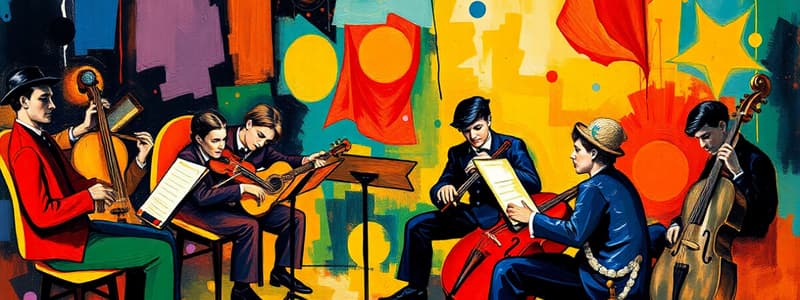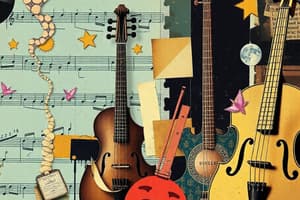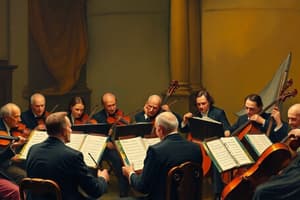Podcast
Questions and Answers
Which statement accurately describes the evolution of orchestras?
Which statement accurately describes the evolution of orchestras?
- Orchestras were initially developed in the 20th century as a medium for experimental and atonal music.
- Orchestras originated as predominantly percussion-based ensembles and gradually incorporated string and wind instruments.
- The size and composition of orchestras have remained relatively consistent since their inception in the early Renaissance period.
- Orchestras evolved from smaller instrumental groups during the Renaissance and Baroque periods, culminating in the modern symphony orchestra. (correct)
If a composer seeks to highlight the unique timbre of plucked string instruments within an orchestral piece, which instrument would be most appropriate to feature?
If a composer seeks to highlight the unique timbre of plucked string instruments within an orchestral piece, which instrument would be most appropriate to feature?
- Tuba
- Harp (correct)
- Timpani
- Oboe
In an orchestral score, which instrumental family is traditionally positioned at the top?
In an orchestral score, which instrumental family is traditionally positioned at the top?
- Woodwinds (correct)
- Percussion
- Strings
- Brass
What is the primary role of the conductor in an orchestra?
What is the primary role of the conductor in an orchestra?
Which type of orchestral composition typically features a solo instrument accompanied by the orchestra?
Which type of orchestral composition typically features a solo instrument accompanied by the orchestra?
Which of the following instruments is NOT a member of the brass family in an orchestra?
Which of the following instruments is NOT a member of the brass family in an orchestra?
An orchestra is preparing to perform a piece that requires a wide dynamic range and complex rhythmic passages. Which instrumental section is most crucial for providing a strong rhythmic foundation and a variety of percussive sounds?
An orchestra is preparing to perform a piece that requires a wide dynamic range and complex rhythmic passages. Which instrumental section is most crucial for providing a strong rhythmic foundation and a variety of percussive sounds?
A music educator aims to demonstrate the unique sound produced solely by string instruments. Which type of orchestra would be most suitable for this demonstration?
A music educator aims to demonstrate the unique sound produced solely by string instruments. Which type of orchestra would be most suitable for this demonstration?
Apart from performing existing musical works, how else do orchestras impact the cultural and artistic landscape?
Apart from performing existing musical works, how else do orchestras impact the cultural and artistic landscape?
What is the primary function of an orchestral score?
What is the primary function of an orchestral score?
Flashcards
What is an orchestra?
What is an orchestra?
A large instrumental ensemble with string, brass, woodwind, and percussion sections.
What are string orchestras?
What are string orchestras?
Orchestras composed entirely of string instruments.
What is a chamber orchestra?
What is a chamber orchestra?
An orchestra of intermediate size, typically with fifteen to forty members.
Who is a conductor?
Who is a conductor?
Signup and view all the flashcards
How do string instruments make sound?
How do string instruments make sound?
Signup and view all the flashcards
How do woodwind instruments make sound?
How do woodwind instruments make sound?
Signup and view all the flashcards
How do brass instruments make sound?
How do brass instruments make sound?
Signup and view all the flashcards
How do percussion instruments make sound?
How do percussion instruments make sound?
Signup and view all the flashcards
What is an orchestral score?
What is an orchestral score?
Signup and view all the flashcards
What is orchestral repertoire?
What is orchestral repertoire?
Signup and view all the flashcards
Study Notes
- An orchestra is a large instrumental ensemble that contains sections of string, brass, woodwind, and percussion instruments
Types of Orchestras
- Symphony orchestras commonly have over eighty musicians, sometimes one hundred or more
- String orchestras are smaller ensembles comprised only of string instruments
- Chamber orchestras are of intermediate size, with fifteen to forty members
Instrumentation
- Orchestras are typically led by a conductor who directs the performance and interprets the music
- Orchestras include instruments from four main families
- Strings: Violins, violas, cellos, and double basses which produce sound through vibrating strings
- Woodwinds: Flutes, oboes, clarinets, and bassoons which produce sound by blowing air through a reed or across an edge
- Brass: Trumpets, trombones, French horns, and tubas which produce sound by buzzing the lips into a mouthpiece
- Percussion: Timpani, snare drum, bass drum, cymbals, and other instruments that produce sound by being struck, shaken, or scraped
- Other instruments, such as the piano, harp, and saxophone, may appear in an orchestra
Arrangement
- Music for orchestras is written in the form of a score
- The score shows all the instrumental parts
- A score allows the conductor to see what each instrumentalist should play
- Orchestral scores are complex documents
- Instrumental families are grouped together on the page
- From top to bottom, the organization of the score is woodwinds, brass, percussion, and strings
History
- Orchestras evolved from various instrumental ensembles during the Renaissance and Baroque periods
- The modern symphony orchestra took shape in the late 18th and early 19th centuries
- Key figures in the development of the orchestra include composers such as Joseph Haydn, Wolfgang Amadeus Mozart and Ludwig van Beethoven
- Over time, the size and composition of the orchestra expanded, driven by the demands of composers and the development of new instruments
Repertoire
- The orchestral repertoire covers a vast range of musical styles and periods including
- Symphonies
- Concertos
- Overtures
- Suites
- Tone poems
- Ballets and Operas
- Orchestras perform works by classical composers as well as contemporary pieces
- Orchestras often collaborate with soloists, choirs, and other ensembles
Impact
- Orchestras are cultural institutions, contributing to the preservation and promotion of classical music
- Orchestras provide educational outreach programs, introducing young people to the world of orchestral music
- Orchestras commission new works by contemporary composers, fostering creativity
- Orchestral performances enrich communities, offering opportunities for artistic expression and cultural engagement
Studying That Suits You
Use AI to generate personalized quizzes and flashcards to suit your learning preferences.




